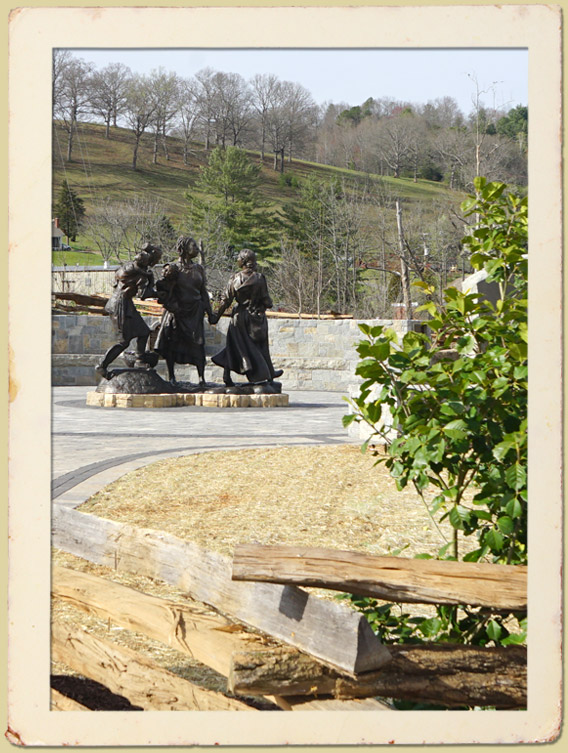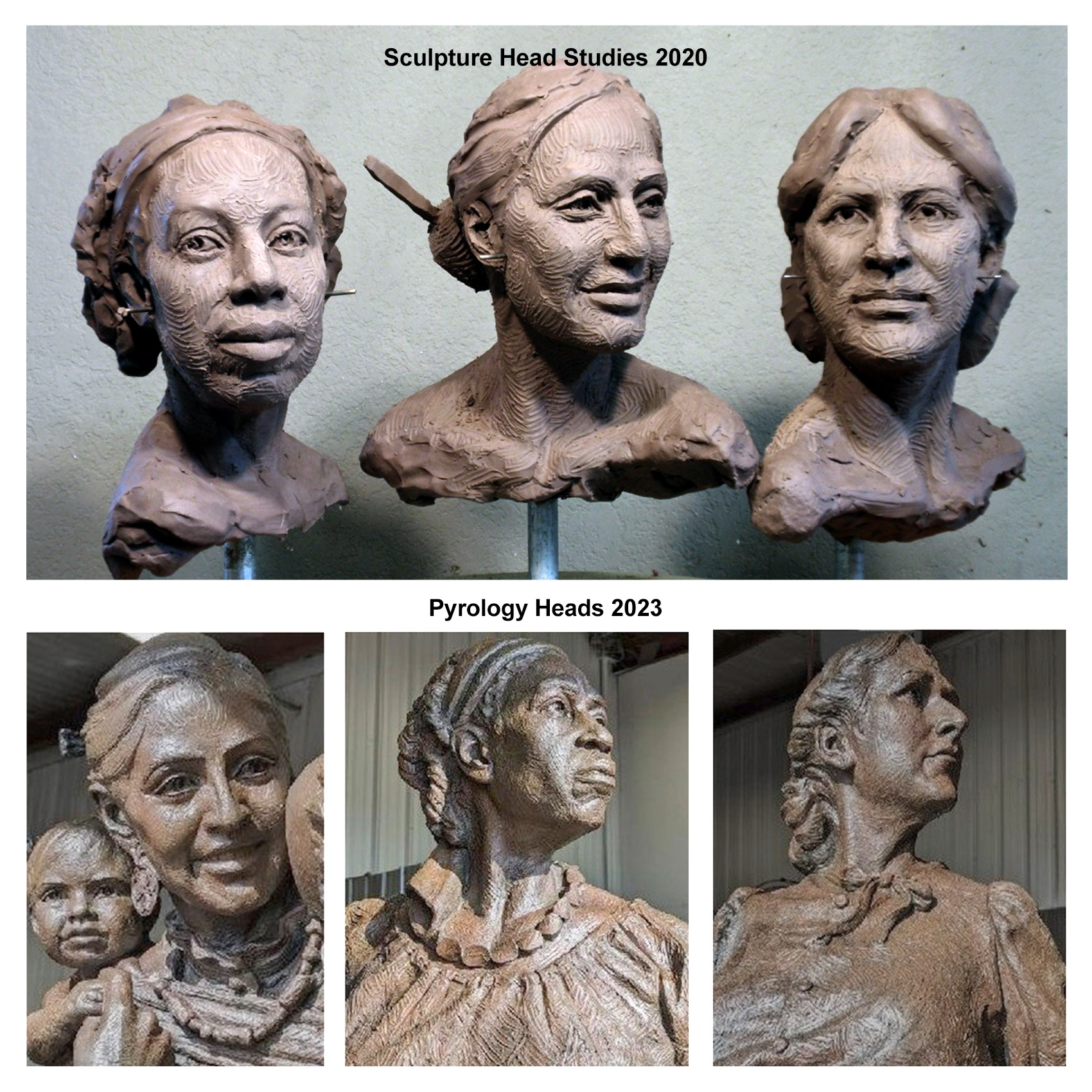
WHT Sculpture: "Sowing the Seeds of the Future"
Artist Statement: Wesley Wofford; FNSS, PSS
This sculpture tells the story of three women - a Cherokee woman, an enslaved woman, and a pioneer woman - all connected by a specific piece of property that was on the Little Tennessee River across from the Noquisiyi (sometimes rendered as Nikwasi) Mound. It represents these historical women but also symbolizes each group of women and their cultural contributions that helped forge modern-day Franklin – and modern-day America.
The base on which the three figures stand represents the passage of time: the Noquisiyi Mound as a cultural and spiritual center of the Cherokee people which became the muddy early town, where creek stones became cobblestone streets and eventually the modern town of Franklin. The seeds within the sculpture literally represent the crucial importance of agriculture, but also symbolize the transfer of knowledge across cultures and generations. The hands of the women are all touching, illustrating the ideal of a sisterhood of women that can help bridge the cultural divides present both then and now. The details of each figure reflect specific elements of each woman’s culture and the place in society each woman held. The sculpture is a metaphor for the evolution of modern society, a narrative about three local women, as well as a history lesson with embedded historically accurate details. It is intended to acknowledge and celebrate women's contributions, to inspire future generations of girls and women to pursue their dreams, and to challenge us all to learn from the past and aspire for a more equitable future.

Na-Ka Rebecca Morris was a Cherokee woman born in Noquisiyi in 1792, daughter of Nancy whose brother was the well-known chief, Yonaguska. She married Gideon Morris, a farmer and Baptist preacher from South Carolina. In 1819 they obtained a 640-acre reserve on the east side of the Little Tennessee River, across from the Noquisiyi Mound, in what is now East Franklin. Just a year later, they were burned out of their home and forced to give up their land. They moved to downtown Franklin, where they lived until 1833. They then moved to the Valley River in what is now Cherokee County. Finally, in 1867, they chose to move to Indian Territory in Oklahoma, where they stayed for the rest of their long lives.
In the sculpture, Na-Ka Rebecca is seen passing corn seeds to a young girl. The Cherokee for generations used Noquisiyi Mound and the surrounding land to celebrate the annual Green Corn Festival. Na-ka Rebecca is standing on a mound, which honors the Noquisiyi site and represents the foundation on which the entire town of Franklin was built. She is elevated in comparison to the other women, a reference to women being the landowners in Cherokee society. Children belonged to their mother’s clan, and women had authority in their households and in the clan, and property descended through the women. On the top of the mound is the symbol of the water spider bringing fire to the people on her back and representing the importance of fire that was part of the tradition of the mound and the festival. The sweeping lines at the base of the mound are reminiscent of the pottery patterns excavated from Coweeta Creek, with the four concentric 9’s around the base, representing the four cardinal directions. They are the wind, and as they move from the mound on the base they pass over the river and become the water, carrying the voices and traditions of the Cherokee into the future. A burden basket full of corn is at Na-Ka Rebecca’s feet, depicting the agricultural responsibilities of women. The diamond shaped design on the traditional Cherokee basket is a variation of the Chief’s Daughter’s pattern and gives homage to Na-Ka Rebecca’s standing as the granddaughter and niece of chiefs. The basket is full of corn for the festival, and is embedded into the mound, highlighting the ritual of bringing soil annually to add to the mound. Na-ka Rebecca’s attire represents hundreds of years of history. Her expression is kind and giving. Despite having endured the violent upheaval of the time of the Removal, she has the grace to share her cultural knowledge. Her child is on her back tied in the traditional wrap manner. She is looking to the future, toward the long and harrowing journey of her descendants to re-establish the modern-day Cherokee Nation.
The central figure of the composition is Salley, an African American enslaved woman. The few documentary references to her give us an outline of her life’s path. It is believed that she was born into slavery around 1799 and at some point, came to live with the Cherokee, probably as a servant to Na-ka. Salley spoke Cherokee and must have lived with the Tribe for several years. It seems likely that she would have gone with Na-ka Rebecca after she was married and lived in the Morris household until she was sold to Jesse and Harriet Siler (Timoxena’s parents) in 1821. Salley would have learned many skills from living with the Cherokee, including how to use native plants for nutrition, medicine, dyeing, and other purposes. She was about the same age as Harriet Siler and assisted in the household while young Timoxena was growing up. In the sculpture, Salley is the bridge and conduit between the two women and the two cultures. Her attire is a modest ensemble, that of an enslaved person, but also with some of her own African traditions such as the scoop neck top necklace and head wrap with braided hair. She stands proud and resolute with a young Timoxena on her hip, lost in thought about the freedom that she may never attain, unaware that in the future all of the enslaved will reach emancipation. They are standing on the muddy riverbank of the Little Tennessee River, perhaps having taken their shoes off to play, gather water, or do some washing. She is strong and sturdy, and although her mark in history is tragic, Franklin would not be what it is today if not for her toils and contributions.
Harriet Timoxena Siler, born in 1835, was the daughter of the early settlers Jesse and Harriet Siler. The house where she was born and raised still stands on West Main Street in Franklin and is visible from the Methodist Cemetery. She married William “Billy” Sloan in 1856, and together they acquired, as a wedding present from her father, Jesse, the southern part of what had originally been Na-Ka Rebecca and Gideon’s reserve. Salley moved with them to their new property, where she had previously lived with Na-ka Rebecca.
Historical research and family tradition paint “Tim” (as Timoxena she was called) as a thrifty, frugal, and well-educated woman who could cook, sew, and even make her own medicines. Sadly, she became a widow at 40 years old and had to bear the burden of running the household and raising six children. Salley was likely deeply involved in all of this work, including caring for the children. In the sculpture, Timoxena appears twice, once as a young girl on Salley’s hip, being graciously given the seeds of knowledge and survival from Na-ka. Later she is a grown woman striding into the future, hand on her pregnant belly, touching the unseen hand within. Her gaze is towards Salley, a woman she has known her entire life, whom she relies on more and more after her husband’s passing. She is holding Salley’s hand, perhaps reassuring her that the future will be brighter for all of them. The adult Timoxena has a harvest bag on her shoulder filled with corn and apples, the former passed down from the Cherokee, and the latter introduced by her frontier ancestors. Her attire represents the European and colonial influences that shaped modern America, with her work boots not quite matching her dress, and her sleeves rolled up, speaking of the duality of her roles. She is a leader, carrying forward the skills passed on to her through generations of strong women.

WHT Sculpture Community Celebration Day
The Folk Heritage Association of Macon County and Women's History Trail saw hundreds of people join in the celebration and dedication of the "Sowing the Seeds of the Future" sculpture at Women's History Park on Saturday, March 23, 2024.
The Unveiling Ceremony, Sculpture Dedication, WHT Trailhead Designation and Donation to the Town of Franklin were all featured during the celebration that began at 11:00am.
Blue Jazz thrilled those in attendance with their music and a special rendention of the Sam Cooke classic, "Change Is Gonna Come".
» Click here to read all about the celebration and view photos from the day's activities.
Presented with Support from the Town of Franklin, TDA, TDC, Arts Council of Macon County, Cowee School Arts & Heritage Center & Individual Donors.

